-
 By Derek Duckworth
By Derek Duckworth
- October 13, 2025
- 0 Comments
- Chat Room News
Analysing Chat Rooms Before Social Media: How Early Researchers Tried to Understand Online Conversations
Before TikTok, Discord, or WhatsApp, researchers were already trying to decode how people especially kids talk online. Around the year 2000, one project in Berlin tried to record real conversations in chat rooms used by teenagers. It sounds simple today, but it turned out to be a logistical nightmare. Between anonymity, primitive logging tools, and privacy rules for minors, this early study highlighted just how hard it is to capture authentic chat communication.
Here’s what they learned, why it still matters, and how chat platforms like World of Chat handle similar challenges today.

The Berlin Chat Research Project
Led by Claudia Orthmann and funded by Freie Universität Berlin (FU Berlin) between 1999 and 2000, the Berlin Chat Research Project was one of the first systematic attempts to study online communication patterns among children and teenagers aged 10-17. This pioneering research aimed to understand how young people adapted to digital communication environments long before social media became ubiquitous.
The project faced numerous challenges that modern researchers might find surprising. With limited technology and no established methodologies for studying online interactions, the team had to develop innovative approaches to data collection.
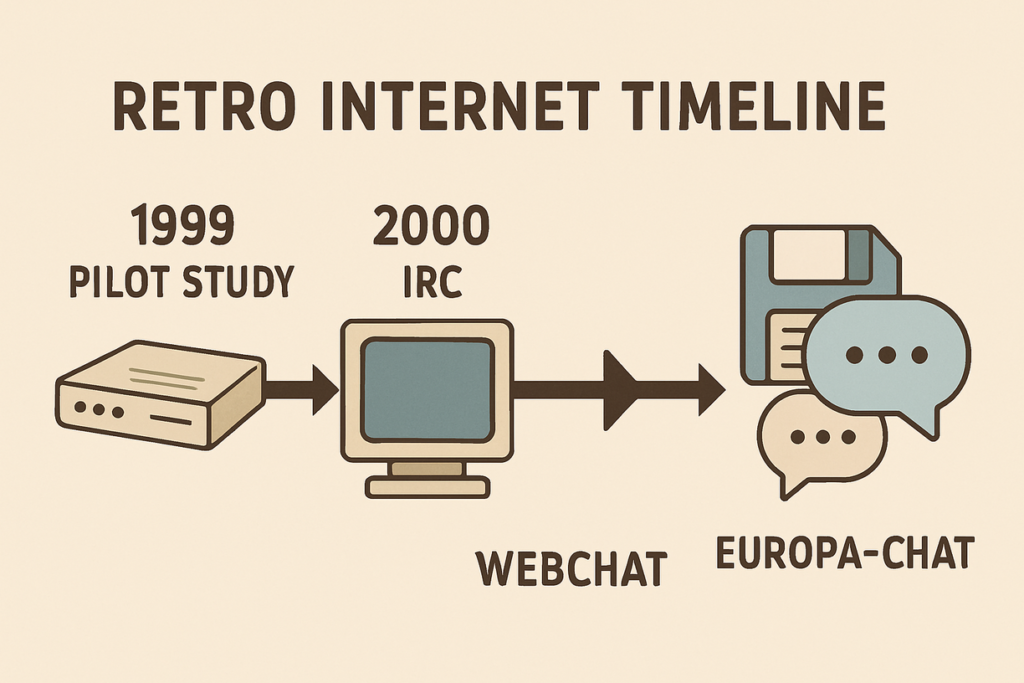
The research team attempted three distinct data-collection methods, each with its own advantages and limitations:
- IRC (Internet Relay Chat) monitoring via internet cafés
- Webchat observations with controlled laboratory settings
- Europa-Chat logs from Berlin’s youth centers
Each approach revealed different aspects of online communication while highlighting the methodological challenges of studying digital interaction in its early forms. The project’s findings continue to influence how we understand online communication development, particularly among younger users.
The Challenges of Studying Chat Rooms
The Berlin Chat Research Project encountered several significant barriers that complicated their research efforts. These challenges reveal why early online communication was so difficult to study systematically.
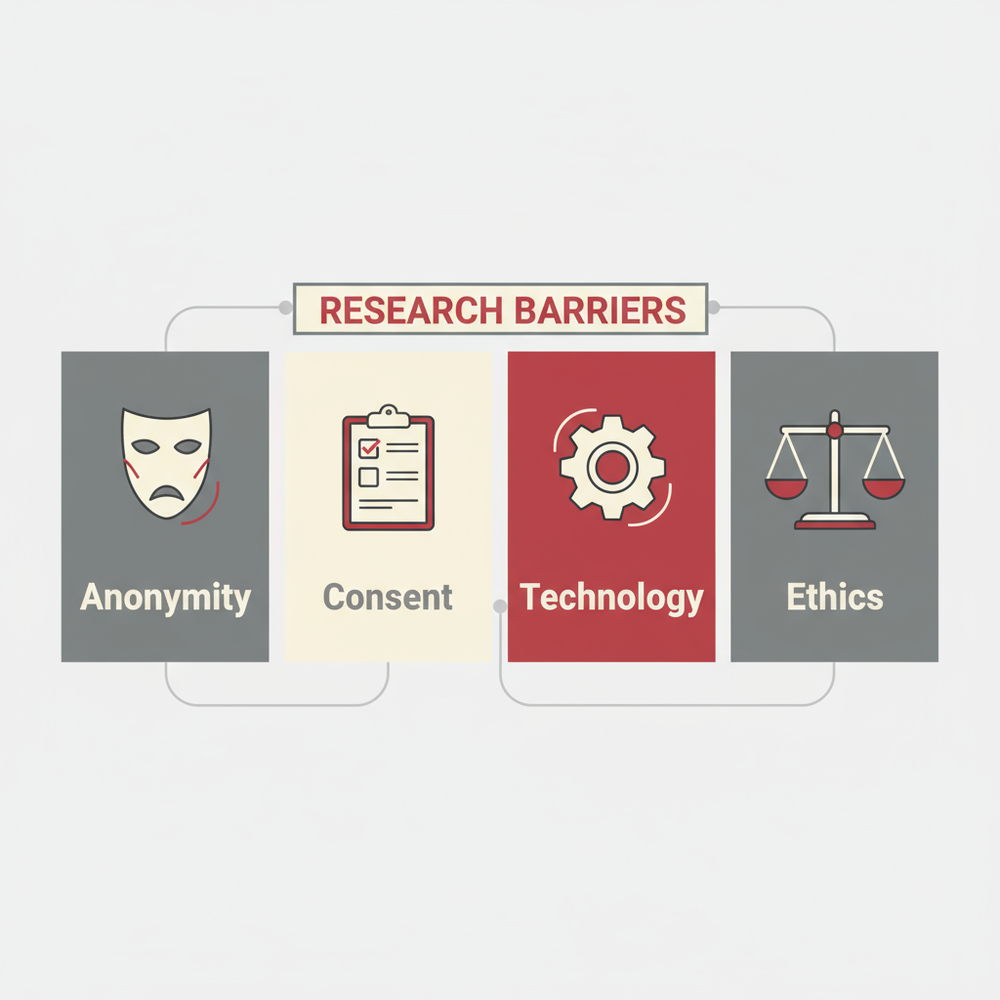
The fascination of anonymity that draws users to chat rooms is the same thing that makes them so hard to study.
— Berlin Chat Research Project Report, 2000
Identity Verification
One of the most significant challenges was the impossibility of verifying users’ true age or identity online. Researchers couldn’t determine if participants were actually within their target demographic of 10-17 year olds or adults posing as teenagers. This anonymity, while central to chat room appeal, created substantial methodological problems.
Consent Issues
Obtaining parental consent for minors proved exceptionally difficult in the online environment. The need for proper research ethics required parental permission, but this significantly reduced participation rates and potentially skewed the sample toward certain demographic groups.
Technical Limitations
In 2000, few chat systems saved transcripts automatically. Researchers had to develop custom logging solutions or rely on screenshots taken at regular intervals, creating gaps in data collection and potential for missing important interactions.
Ethical Boundaries
Researchers couldn’t record private “whisper” messages between users without consent, limiting their view to only public conversations. This created an incomplete picture of chat room communication, as private messages often contained different communication patterns.
Perhaps most significantly, laboratory settings created artificial environments that altered natural behavior. When participants knew they were being observed, their communication patterns changed substantially, raising questions about the authenticity of the data collected.
How They Collected Real Data
The Berlin team employed three distinct methodologies to overcome the challenges of studying authentic chat behavior. Each approach offered different insights while highlighting the complexity of capturing genuine online interaction.
| Method | Setting | Pros | Cons |
| IRC Café Logs | Real chat environment with limited user base | Authentic interaction in natural setting | Small sample size, declining IRC popularity |
| Webchat Laboratory | Controlled research environment | Controlled variables, direct observation | Unnatural setting, technical limitations |
| Europa-Chat Logs | Public youth chat with server-side logging | Ethical data collection, authentic interaction | No access to private messages |

IRC Café Project
The research team initially attempted to log chat sessions in internet cafés around Berlin. This approach sought to capture authentic conversations in natural settings. However, by 2000, IRC usage was already declining among teenagers, resulting in a smaller sample than anticipated. While the data collected was authentic, it represented a diminishing portion of online youth communication.
Webchat Experiment
In their laboratory approach, researchers invited teenagers to chat from controlled computer environments. The team took screenshots every 12 seconds to rebuild chat logs, a labor-intensive process that yielded mixed results. Of 28 sessions conducted, only 12 provided usable data. Participants often behaved differently when aware of being observed, raising questions about data authenticity.

Europa-Chat Server Access
The most successful approach came through collaboration with Berlin’s youth centers, which provided access to the Europa-Chat server logs. This public youth chat platform already logged messages server-side, offering natural, authentic, and ethically obtained data. This became the project’s primary dataset, though it still lacked access to private messages between users.
The combination of these three approaches allowed researchers to triangulate findings and develop a more comprehensive understanding of youth chat behavior than any single method could provide.
What They Learned About Chat Culture
The Berlin Chat Research Project yielded fascinating insights into early online communication patterns that continue to inform our understanding of digital interaction today. These findings revealed that chat rooms were far more than simple text exchanges they represented complex social environments with their own norms, hierarchies, and cultural practices.
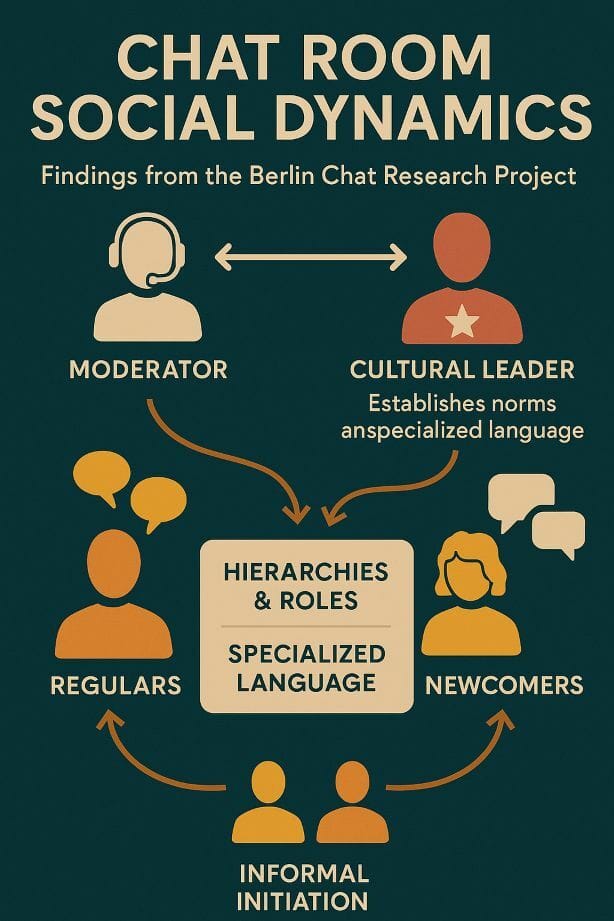
Key Finding: Chat rooms mirrored physical social spaces, with users quickly establishing hierarchies, roles, and specialized language that created distinct cultural environments.
Social Structures in Digital Spaces
One of the most significant discoveries was how chat rooms mirrored physical social spaces. Users quickly established hierarchies, with regular participants gaining status and newcomers going through informal initiation processes. Moderators held positions of authority, while certain users became cultural leaders who influenced conversation norms and slang development.
Adaptation to Digital Communication
Children and teenagers demonstrated remarkable adaptability to digital communication norms. The research showed that young users quickly developed specialized chat shorthand, emoticons (precursors to emoji), and other communication strategies to overcome the limitations of text-only interaction. This adaptability challenged prevailing concerns that digital communication might impair language development.
Technology's Influence on Behavior
The research revealed how technological constraints shaped communication patterns. Slower interfaces resulted in different conversation rhythms and tone compared to faster systems. Users developed strategies to maintain conversation flow despite technical limitations, including parallel conversation threads and specialized attention-getting techniques.
Even 25 years ago, researchers recognized chat as a living culture rather than just text exchanges. The Berlin project documented how users created community norms, developed conflict resolution strategies, and established social boundaries all without face-to-face interaction or formal guidelines.
These insights laid important groundwork for understanding today’s social media interactions and continue to inform how we design digital communication platforms. Read how modern chat behaviour has evolved in our Chat Room History Guide.
Why It Still Matters Today
The challenges and insights from the Berlin Chat Research Project remain remarkably relevant in today’s digital landscape. While technology has evolved dramatically, many of the fundamental questions about online communication, privacy, and community building continue to shape how we design and use digital platforms.
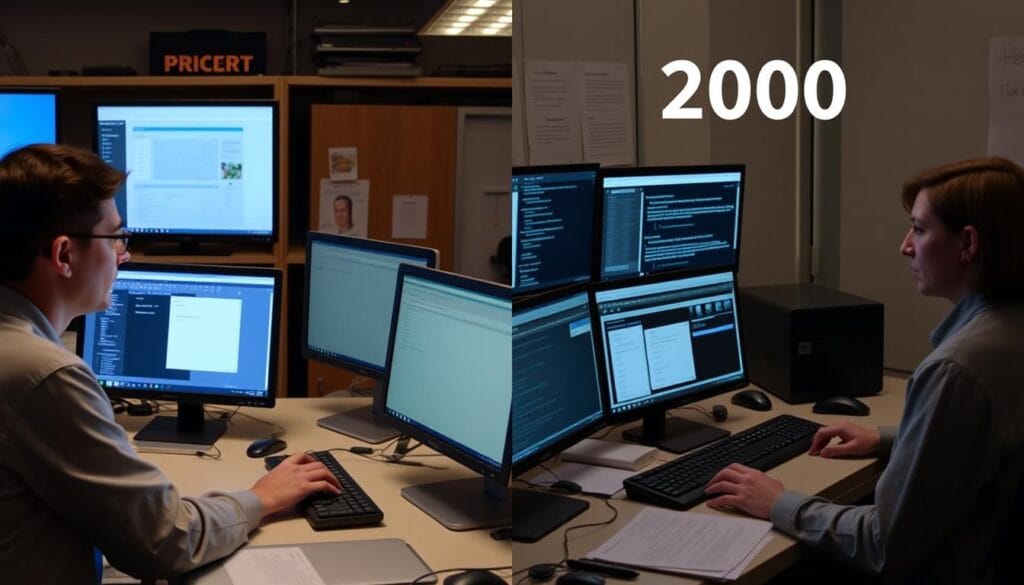
Enduring Research Challenges
Today’s researchers face the same fundamental dilemmas consent, privacy, and authenticity just with faster technology and larger datasets. The Berlin project’s methodological innovations continue to inform how we approach digital communication research, particularly when studying vulnerable populations like children and teenagers.
Designing Safer Digital Spaces
Understanding early chat culture helps modern platforms design safer, more welcoming spaces. The Berlin project’s findings about community formation, moderation, and user behavior provide valuable insights for creating positive online environments that foster healthy interaction while minimizing risks.
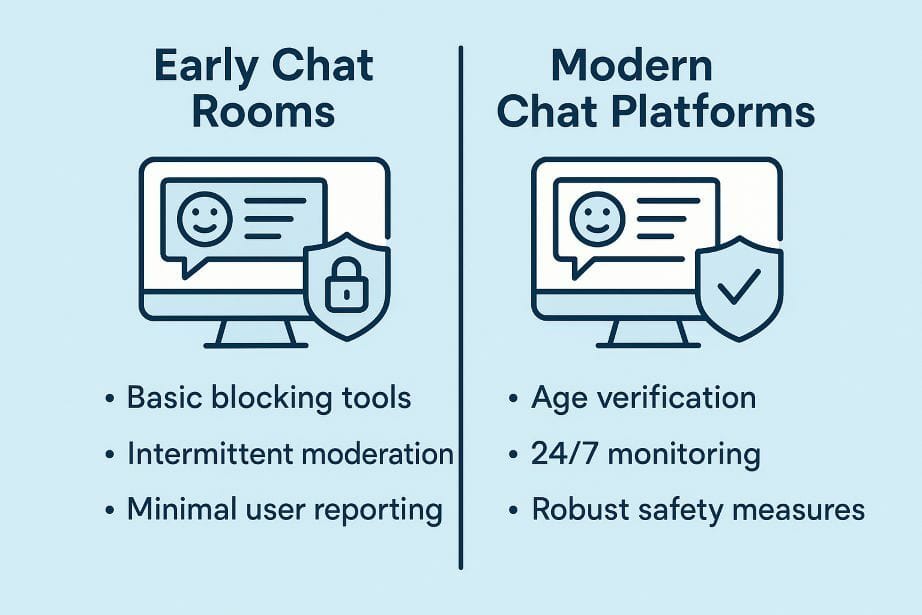
Modern platforms like World of Chat aim to preserve the community-building aspects of early chat rooms while implementing sophisticated safety measures that address the concerns identified by early researchers. By understanding the historical development of online communication, we can build better digital spaces that encourage authentic connection.
The research methods pioneered in Berlin have evolved into sophisticated approaches for studying online interaction, incorporating AI analysis, big data techniques, and cross-platform observation that would have seemed impossible in 2000.
Learn More About Chat Safety
Discover how modern chat platforms implement safety features based on decades of research.
Then vs. Now: The Evolution of Chat Research
The contrast between the Berlin Chat Research Project’s methods and today’s approaches highlights how dramatically digital communication research has evolved while many core questions remain the same.
| Aspect | Berlin Project (2000) | Modern Research (2025) |
| Anonymity | Major challenge for researchers | Age verification and moderation systems help |
| Data Collection | Manual screenshots, limited logging | Automated analytics and AI-assisted monitoring |
| Technology | Text-only IRC and basic webchats | Multi-modal platforms with video, audio, and text |
| Geographic Scope | Local youth centers in Berlin | Global platforms connecting diverse communities |
| Privacy Concerns | Basic ethical guidelines | Comprehensive data protection frameworks |
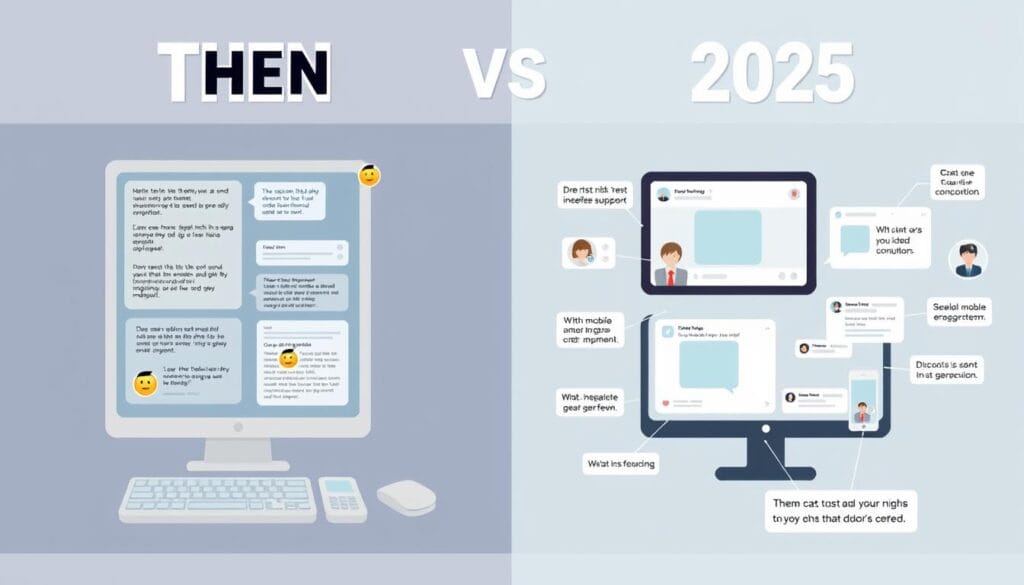
Despite these technological advances, the fundamental questions about how humans connect, communicate, and form communities online remain remarkably consistent. The Berlin Chat Research Project’s pioneering work laid important groundwork for understanding these enduring aspects of digital interaction.
Final Thoughts: The Legacy of Early Chat Research
The Berlin Chat Research Project reminds us that chat rooms have always fascinated people not just as social spaces, but as mirrors of human behavior. Even two decades later, researchers, moderators, and platform owners still grapple with the same balance between privacy, safety, and connection.
What began as a challenging research endeavor in Berlin has evolved into a rich field of study that continues to inform how we design, use, and understand digital communication platforms. The methodological innovations, ethical considerations, and social insights from this early research continue to resonate in today’s complex digital landscape.

As we continue to develop new communication technologies, the lessons from early chat research remind us that behind every message is a human seeking connection, community, and understanding a truth that transcends technological evolution.
Experience Modern Chat Community
Try a real, modern chat experience built on decades of research about what makes online communities thrive.
Further Reading & Sources
Key Research Papers
-
John Suler (2004) – The Online Disinhibition Effect.
https://johnsuler.com/article_pdfs/online_dis_effect.pdf -
Monica Whitty (2002) – Liar, Liar! An Examination of How Open, Supportive and Honest People Are in Chat Rooms.
https://irep.ntu.ac.uk/id/eprint/4279/ -
Scott Caplan (2007) – Relations Among Loneliness, Social Anxiety, and Problematic Internet Use.
https://pubmed.ncbi.nlm.nih.gov/17474841/
Recommended Books
- Alone Together: Why We Expect More from Technology and Less from Each Other – Sherry Turkle (2011). Basic Books.
- The Shallows: What the Internet Is Doing to Our Brains – Nicholas Carr (2010). W.W. Norton & Company.
- Reader, Come Home: The Reading Brain in a Digital World – Maryanne Wolf (2018). HarperCollins.
- iGen: Why Today’s Super-Connected Kids Are Growing Up Less Rebellious, More Tolerant, and Less Happy – Jean Twenge (2017). Atria Books.



